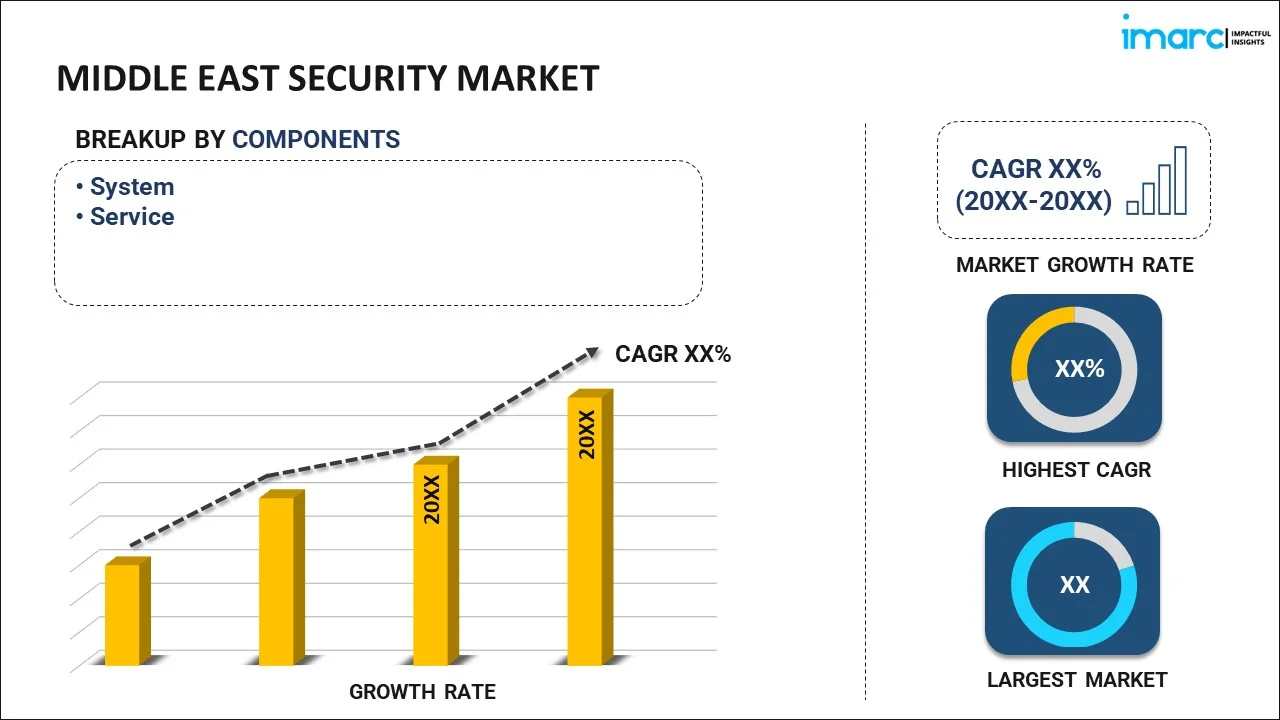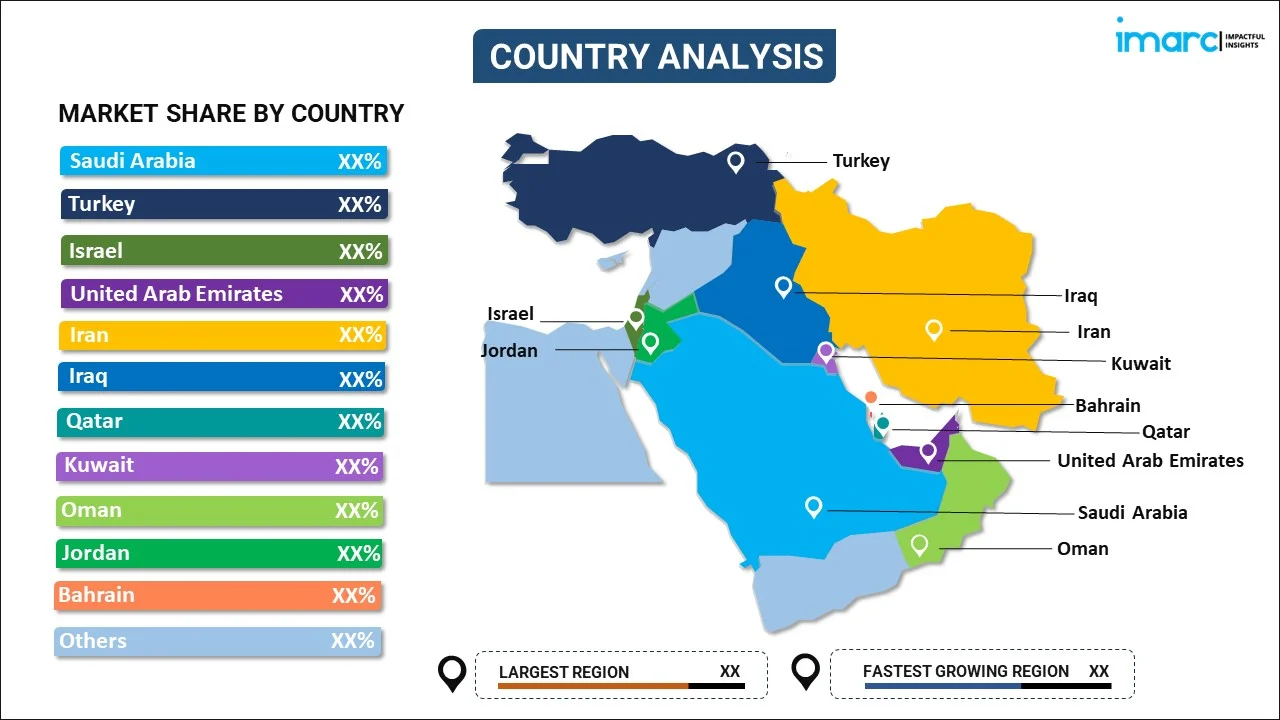
Middle East Security Market Report by Component (System, Service), End User (Government, Military and Defense, Transportation, Commercial, Industrial, and Others), and Country 2024-2032
Market Overview:
Middle East security market size is projected to exhibit a growth rate (CAGR) of 13.91% during 2024-2032. The market is being propelled by an increasing embrace of sophisticated security systems to safeguard assets and manage risks, a rise in employment within the transportation sector to enhance passenger safety, and a surge in incidents of cybercrimes, cyber threats, and data breaches.
|
Report Attribute
|
Key Statistics
|
|---|---|
|
Base Year
|
2023 |
|
Forecast Years
|
2024-2032
|
|
Historical Years
|
2018-2023
|
| Market Growth Rate (2024-2032) | 13.91% |
Security entails a holistic approach to safeguarding digital systems, networks, and data from unauthorized access, attacks, and potential harm. It employs a combination of strategies, technologies, and practices aimed at ensuring the confidentiality, integrity, and availability of digital assets. The primary goal is to mitigate risks associated with cyber threats, encompassing challenges like hacking, malware, and data breaches. Security offers a range of benefits, including the protection of sensitive information, prevention of financial losses, preservation of business reputation, and the maintenance of user trust. Its application spans various sectors, encompassing business, government, healthcare, and personal computing. Within its purview, security comprises distinct types such as network security, application security, and endpoint security, each tailored to address specific vulnerabilities in the digital landscape.
Middle East Security Market Trends:
The security market in the Middle East epitomizes a dynamic and comprehensive approach to safeguarding digital systems, networks, and data within the region. Fueled by the increasing sophistication of cyber threats, this market is characterized by a combination of strategies, technologies, and practices aimed at ensuring the confidentiality, integrity, and availability of digital assets. Additionally, the core objective is to counteract risks posed by various cyber threats, including hacking, malware, and data breaches, which is acting as another significant growth-inducing factor. Apart from this, advantages of a robust security infrastructure in the Middle East include not only the protection of sensitive information but also the prevention of financial losses, preservation of business reputation, and the crucial maintenance of user trust. With applications spanning diverse sectors such as business, government, healthcare, and personal computing, the Middle East security market is pivotal in fortifying the digital resilience of these entities. It encompasses various security types, including network security, application security, and endpoint security, each specifically addressing vulnerabilities within the digital landscape. As the region continues to witness technological advancements and an increasing reliance on digital platforms, the Middle East security market will play a pivotal role in shaping a secure and resilient digital ecosystem over the forecasted period.
Middle East Security Market Segmentation:
IMARC Group provides an analysis of the key trends in each segment of the market, along with forecasts at the regional and country levels for 2024-2032. Our report has categorized the market based on component and end user.
Component Insights:

- System
- Access Control Systems
- Alarms and Notification Systems
- Intrusion Detection Systems
- Video Surveillance Systems
- Barrier Systems
- Others
- Service
- System Integration and Consulting
- Risk Assessment and Analysis
- Managed Services
- Maintenance and Support
The report has provided a detailed breakup and analysis of the market based on the Component. This includes system (access control systems, alarms and notification systems, intrusion detection systems, video surveillance systems, barrier systems, and others) and service (system integration and consulting, risk assessment and analysis, managed services, and maintenance and support).
End User Insights:
- Government
- Military and Defense
- Transportation
- Commercial
- Industrial
- Others
A detailed breakup and analysis of the market based on the end user have also been provided in the report. This includes government, military and defense, transportation, commercial, industrial, and others.
Country Insights:

- Saudi Arabia
- Turkey
- Israel
- United Arab Emirates
- Iran
- Iraq
- Qatar
- Kuwait
- Oman
- Jordan
- Bahrain
- Others
The report has also provided a comprehensive analysis of all the major regional markets, which include Saudi Arabia, Turkey, Israel, United Arab Emirates, Iran, Iraq, Qatar, Kuwait, Oman, Jordan, Bahrain, and Others.
Competitive Landscape:
The market research report has also provided a comprehensive analysis of the competitive landscape in the market. Competitive analysis such as market structure, key player positioning, top winning strategies, competitive dashboard, and company evaluation quadrant has been covered in the report. Also, detailed profiles of all major companies have been provided.
Middle East Security Market Report Coverage:
| Report Features | Details |
|---|---|
| Base Year of the Analysis | 2023 |
| Historical Period | 2018-2023 |
| Forecast Period | 2024-2032 |
| Units | US$ Million |
| Scope of the Report | Exploration of Historical and Forecast Trends, Industry Catalysts and Challenges, Segment-Wise Historical and Predictive Market Assessment:
|
| Components Covered |
|
| End Users Covered | Government, Military and Defense, Transportation, Commercial, Industrial, Others |
| Countries Covered | Saudi Arabia, Turkey, Israel, United Arab Emirates, Iran, Iraq, Qatar, Kuwait, Oman, Jordan, Bahrain, Others |
| Customization Scope | 10% Free Customization |
| Report Price and Purchase Option | Single User License: US$ 3699 Five User License: US$ 4699 Corporate License: US$ 5699 |
| Post-Sale Analyst Support | 10-12 Weeks |
| Delivery Format | PDF and Excel through Email (We can also provide the editable version of the report in PPT/Word format on special request) |
Key Questions Answered in This Report:
- How has the Middle East security market performed so far and how will it perform in the coming years?
- What has been the impact of COVID-19 on the Middle East security market?
- What is the breakup of the Middle East security market on the basis of component?
- What is the breakup of the Middle East security market on the basis of end user?
- What are the various stages in the value chain of the Middle East security market?
- What are the key driving factors and challenges in the Middle East security?
- What is the structure of the Middle East security market and who are the key players?
- What is the degree of competition in the Middle East security market?
Key Benefits for Stakeholders:
- IMARC’s industry report offers a comprehensive quantitative analysis of various market segments, historical and current market trends, market forecasts, and dynamics of the Middle East security market from 2018-2032.
- The research report provides the latest information on the market drivers, challenges, and opportunities in the Middle East security market.
- Porter's five forces analysis assist stakeholders in assessing the impact of new entrants, competitive rivalry, supplier power, buyer power, and the threat of substitution. It helps stakeholders to analyze the level of competition within the Middle East security industry and its attractiveness.
- Competitive landscape allows stakeholders to understand their competitive environment and provides an insight into the current positions of key players in the market.
Need more help?
- Speak to our experienced analysts for insights on the current market scenarios.
- Include additional segments and countries to customize the report as per your requirement.
- Gain an unparalleled competitive advantage in your domain by understanding how to utilize the report and positively impacting your operations and revenue.
- For further assistance, please connect with our analysts.
 Inquire Before Buying
Inquire Before Buying
 Speak to an Analyst
Speak to an Analyst
 Request Brochure
Request Brochure
 Request Customization
Request Customization




.webp)




.webp)












